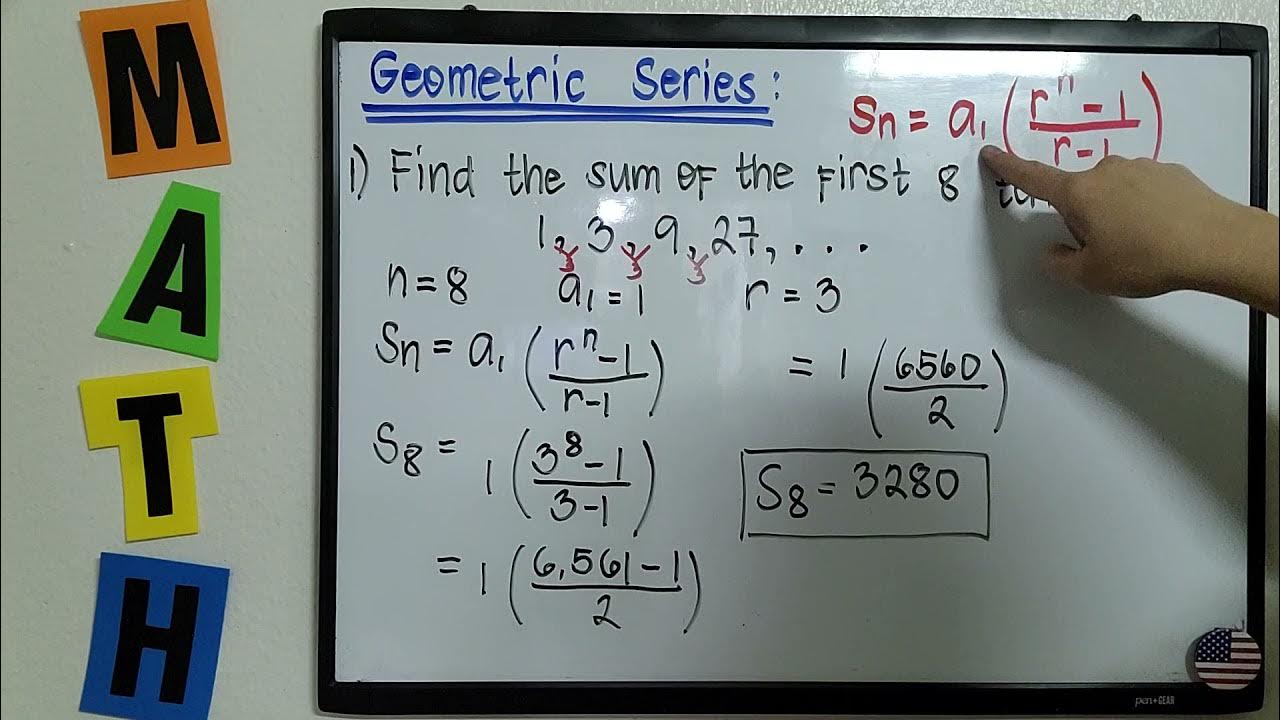Sequences and series (part 2)
Summary
TLDRThis educational video script explores the concept of geometric series, demonstrating how to calculate their sum using the formula S = (a^{n+1} - 1) / (a - 1). It illustrates the process with examples, including the intriguing scenario where the sum of an infinite geometric series with a base of 1/2 converges to 2. The script effectively conveys the beauty of mathematics by showing how an infinite series can result in a finite, calculable sum.
Takeaways
- 🧮 The video continues from where the previous one left off, discussing the geometric series.
- 🔢 A geometric series involves summing terms of the form 'a^k' where 'a' is a constant and 'k' is the exponent.
- 🧠 The speaker defines the geometric sum (S) and introduces another sum (a * S) to help simplify the calculation.
- ➖ Subtracting the second sum (a * S) from the first sum (S) leads to the cancellation of many terms, simplifying the expression.
- ✏️ The resulting formula for the sum of a geometric series is S = (a^(n+1) - 1) / (a - 1).
- 🔍 The formula is useful for calculating the sum of finite geometric series, such as summing powers of 3 up to 3^10.
- ♾️ The speaker transitions to discussing infinite geometric series, which converge if the base 'a' is less than 1.
- ⚖️ When the base 'a' is a fraction (like 1/2), the terms get smaller and smaller as the series progresses.
- 🔗 The formula can also be applied to infinite series, and as n approaches infinity, the sum converges to a finite number.
- 🎯 A specific example is given: the sum of 1/2, 1/4, 1/8, etc., converges to the value 2.
Q & A
What is a geometric series?
-A geometric series is a sequence of numbers where each term after the first is found by multiplying the previous one by a fixed, non-zero number called the common ratio.
What is the sum of a geometric series with the first term 'a' and the last term 'a^n'?
-The sum S of a geometric series from a^0 to a^n can be calculated using the formula S = a^(n+1) - 1 / (a - 1), provided that the common ratio 'a' is not equal to 1.
Why did the presenter correct 'a^(n-2)' to 'a^n' in the script?
-The presenter corrected 'a^(n-2)' to 'a^n' because the original notation was incorrect. The series should include terms up to 'a' raised to the power of 'n', not 'n-2'.
How does the presenter define the sum 's' in the script?
-The presenter defines 's' as the sum of a geometric series, which is the sum of terms from 'a^0' to 'a^n'.
What is the purpose of defining another sum 'a*s' in the script?
-Defining 'a*s' allows the presenter to create an equation that, when simplified, helps derive the formula for the sum of a geometric series.
What happens when the presenter subtracts 's' from 'a*s' in the script?
-When 's' is subtracted from 'a*s', all terms except the first ('a^0') and the last ('a^(n+1)') cancel out, leaving 'a^(n+1) - 1'.
Why does the presenter multiply the top and bottom of the fraction by -1 in the script?
-The presenter multiplies the top and bottom by -1 to simplify the fraction and make it easier to understand that the sum of an infinite geometric series with a ratio of 1/2 is 2.
What is the significance of the presenter's question about subtracting 's' from 'a*s'?
-This question is significant because it leads to the discovery that the sum of a geometric series can be represented by a simple formula, which is crucial for understanding the properties of geometric series.
How does the presenter demonstrate the concept of an infinite geometric series?
-The presenter demonstrates an infinite geometric series by considering a series with a common ratio of 1/2 and showing that the sum converges to a finite number (2) as the number of terms approaches infinity.
What does the presenter suggest as a project to further understand geometric series?
-The presenter suggests drawing out an infinite geometric series as a pie chart to visualize how adding smaller and smaller pieces results in a finite sum.
Why is the sum of an infinite geometric series with a ratio of 1/2 equal to 2?
-The sum equals 2 because as the number of terms approaches infinity, the terms become infinitesimally small and approach zero, leaving only the first term 'a^0' which is 1, and the last term 'a^(n+1)' which approaches 1, resulting in the sum being 1/(1 - 1/2) = 2.
Outlines

This section is available to paid users only. Please upgrade to access this part.
Upgrade NowMindmap

This section is available to paid users only. Please upgrade to access this part.
Upgrade NowKeywords

This section is available to paid users only. Please upgrade to access this part.
Upgrade NowHighlights

This section is available to paid users only. Please upgrade to access this part.
Upgrade NowTranscripts

This section is available to paid users only. Please upgrade to access this part.
Upgrade NowBrowse More Related Video
5.0 / 5 (0 votes)





